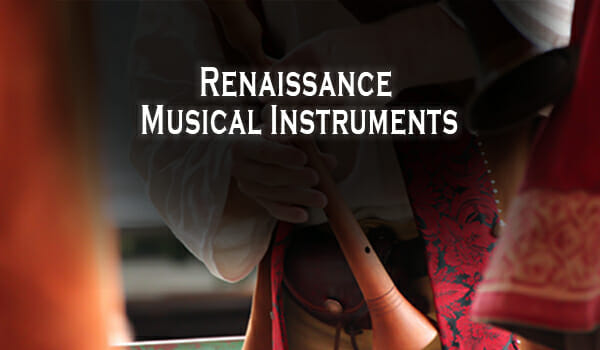
Unless you’re someone who took secret naps in school’s history classes, you would have definitely heard about ‘renaissance‘.
Renaissance was a period in the European continent during which there was a rebirth of arts and literature. Interestingly the word renaissance itself means ‘rebirth‘.
In this revival of arts, music was not obviously forgotten. Renaissance music did not happen with musicians alone but several musical instruments had their role in it. A lot of musical instruments saw their beginning in this period and few others became well-known.
We see a few of them even today, sometimes a little modified versions of them. Let’s dig deep to know more about ten such Renaissance musical instruments.
Table of Contents
- 1. Shawm
- 2. Hurdy-Gurdy
- 3. Recorder
- 4. Cornett
- 5. Bandora
- 6. Harpsichord
- 7. Dulcian
- 8. Viol
- 9. Orpharion
- 10. Virginal
1. Shawm
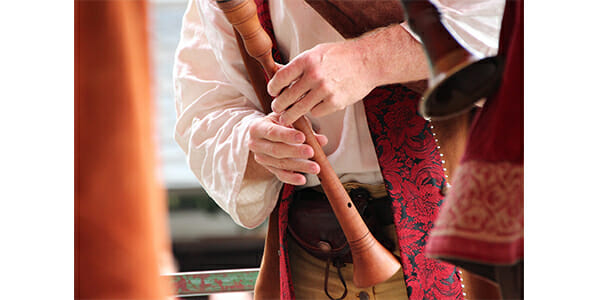
Though it reminds you of Shawn (yeah, we know what crossed your mind), the shawm isn’t a person but a musical instrument.
This is a woodwind instrument and looks very basic. Don’t be fooled by its appearance as the sound it makes is louder than what you could imagine. The shawm is a double reeded instrument made from a single wooden piece.
Shawms were made in the 12th century and became extremely popular during the Renaissance. This instrument is an ancestor of popular instruments like the oboe, basson and charumera of the later time periods.
That doesn’t mean the shawm is extinct now. In the present times, the shawm is used for military purposes.
The sound from the shawm is loud and low pitched. It allows playing only in one octave. Modern version however has an expanded range of octaves which is possible with considerable modifications made in its structure. The finger holes became narrower and so did the bore.
The shawm is a preferred instrument for outdoor performances. Playing this instrument indoors is not ideal as it’s harsh tone sounds unappealing in closed space.
2. Hurdy-Gurdy
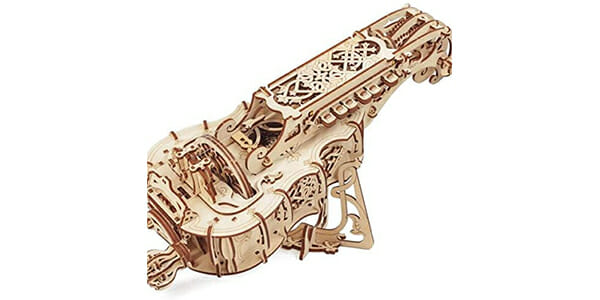
That’s a funny name, but it’s definitely a serious instrument. You will be amazed by its structure and working.
The hurdy-gurdy is a stringed instrument and has another name, the wheel fiddle. It got this name as the sound is generated while the strings move on the wheel of the instrument.
Let’s say the wheel functions like a bow (but is not manually operated like a bow). The instrument resembles the union of the present day’s violin and the keyboard. Whether you are a musician or know nothing about music, the working method of the hurdy-gurdy is sure to amaze you.
The body is usually round in shape and occasionally shaped like a violin too. On top of the head, a keyboard is fixed to play treble notes. The process of sound output is similar to that of a guitar.
Six strings pass through the length of the straight yet short neck of the hurdy-gurdy and can be tuned with the pegs (just like a guitar again). A buzzing bridge is optionally present.
Modern versions of this stringed instrument is available in both electric and electronic forms and is a favorite choice among pop musicians.
Isn’t it super cool that they used an instrument like this way back in the 16th century itself?
3. Recorder
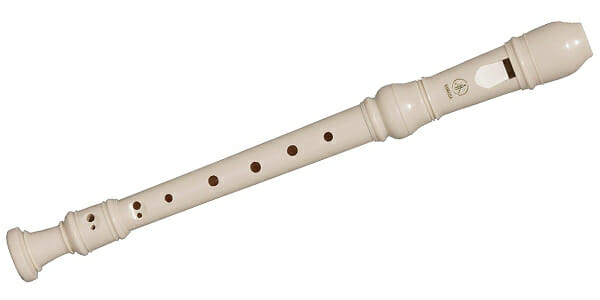
Though the name sounds like a tool used in the recording studios, there indeed is a musical instrument named ‘recorder‘. It is a woodwind instrument and also a fipple flute. (The fipple flute is a flute with a whistle-like mouthpiece.)
Recorders are made in varying shapes with each belonging to different tonal ranges. Irrespective of the size, the recorder usually has seven finger holes.
The recorder was popular during the Renaissance but soon lost its fame. It was however brought back in the 20th century, this time never to go back again. Now, it is a primary musical instrument in western classical music.
Unlike many ancient musical instruments, recorders are melodious and sound as soothing as birds chirping early in the morning. High harmonics and odd harmonics are the reason behind this.
Absence of even harmonics evens out any last chance for production of bass sounds. Complete covering, partial covering and leaving a few holes uncovered are different types of techniques used in playing a recorder to achieve special effects.
Recorder, while being used by the musicians of the olden days, was not explored enough. With time, it was completely studied at a professional level.
4. Cornett
Cornett is a woodwind instrument which is categorized into types based on the sound each one produces. The sound changes with a change in the degree of curvature.
Yet, overall, the structure seems simple.
With its simple looks and a great output, cornett had its place in the hands of professional musicians of each period. The cornett was popular for its usage in the church of ancient days and was used as a pair accompanied with a sackbut trio (sackbut is another popular instrument during the Renaissance).
Its extensive usage does not mean it’s easy to play. Its place was only in professional concerts due to the difficulty involved in learning to play it. It is this difficulty which made the violin an ideal replacement for the cornett (we know that playing the violin is not easy either but easier than the cornett).
The recorder took the place of cornett in modern concerts.
Remember that the CORNET is not CORNETT.
These different spellings are of two different instruments.
5. Bandora

Bandora is also known as bandore and is a string instrument. It was used both as a solo instrument and as an accompaniment with other instruments in the concert.
This is similar to the instruments of the lute family (like a cittern) and has a long neck with six (or seven) courses of strings equipped to it. The bandora looks like a larger version of the orpharion.
The proportion of tuning is exactly like the modern guitar, sometimes with an additional low string. The playability and output is closer to the modern lute than a guitar, though.
Bandora was a popular instrument in the royal households to provide entertainment for the families. In public performances, the bandora was used as a bass instrument due to its deep tonal range. It’s ability to be played chordally was later discovered and exploited to create full range pieces.
As William Barley said, the bandora’s strings are to be plucked gently by the fingers unlike the contemporary string instruments.
6. Harpsichord
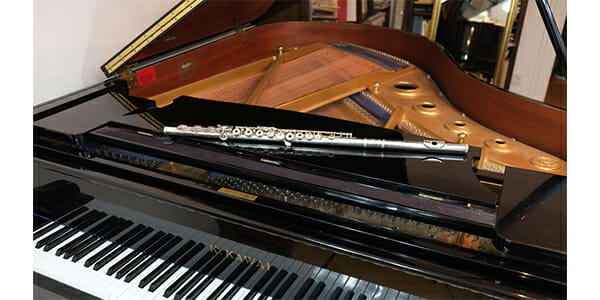
In structure, the harpsichord closely resembles a grand piano and is played with the help of two keyboards. These keyboards can be used together or individually to produce a different range of tones and octaves. It also has a stop button that allows the player to eliminate unwanted octaves.
Though the harpsichord looks like a piano at first glance, it is a string instrument played with plectrums. The keyboards of the harpsichords have white keys for sharps and black keys for full steps which is quite opposite to the conventional color.
The harmonic sounds are maximum in a harpsichord. Therefore, one cannot expect to make beautiful melodies on it unless one is a pro at playing it.
In order to play the harpsichord professionally, the player should be able to connect or divide the sound and to change the expression by changing the speed of playing. A harpsichord player should be well versed with tuning too as the strings are prone to become loose after every performance.
Rare models of harpsichords have three keyboards or a single keyboard with 7 octaves (two keyboards is the conventional structure).
7. Dulcian
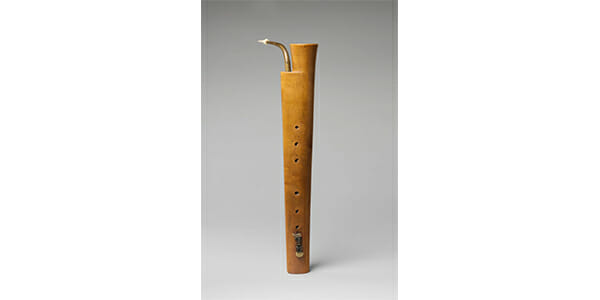
The dulcian was a popular woodwind instrument during the Renaissance. It is a double reed instrument with a folded bore. It was invented way before the Renaissance but enjoyed fame during that period.
This double reed musical instrument is made of a single piece of wood (maple wood, usually). Another piece of wood is sometimes added as a bell. This bell can be muted or unmuted according to the player’s need. Upgraded versions did not require the bell to be removed to be muted and the whole body had a covering of leather.
The dulcian is available in different sizes for different tonal ranges like soprano, alto, tenor and bass. This musical instrument was preferred by the musicians of the Renaissance as it can be used both for outdoors and indoors without having to compromise anywhere. Whether you want to play loud music or quiet music, the dulcian got you covered.
The modern bassoon is often considered the successor to the double reed dulcian.
8. Viol
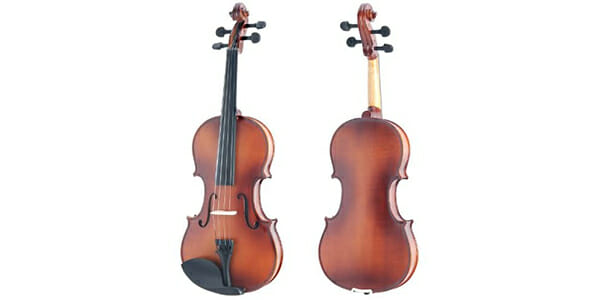
Viol known as viola da gamba in Italian was pretty popular during the Renaissance. In case you didn’t know that viols are different from those of the violin line, they have a non-curvy back with 5 or more strings and also a different mode of tuning. Violins have a curvy back.
Fun fact: ‘da gamba‘ means for the leg while ‘da braccio‘ means for the arm, describing viols and violins respectively.
Modern cello is a close representation of how a viol is played and cello can be called the bass version of a viol. The viol is either plucked or played with a bow, although playing with a bow is commonly observed. The turning of viols is done in fourths unlike many stringed instruments in which tuning is done in fifths.
The viol of the Renaissance was much light in weight and played through plucking. Over time, it evolved to be heavy built.
Viol should not be confused with the viola. Viola belongs to the violin family.
9. Orpharion
As discussed earlier, the orpharion also known as the opherion is a mini version of the bandora. It is a stringed instrument and closely related to the cittern. While the bandora is limited to 7 courses of strings, the orpharion has a probability of 9 courses of strings at the maximum.
The body is pear shaped with a curved border. The strings run through the length of the fret board and can be tuned with the pegs at the top. Frets on the board are made of thick metal making it easy for the fingers to move from low to high notes.
An orpharion’s low tension metal strings are gently plucked to produce a sweet and soothing sound. Before the Renaissance, the orpharion was used as an alternative to the lute. Lute requires a sharper plucking, though.
Currently, there are a few surviving orpharions with courses of strings ranging from 7 to 9.
10. Virginal
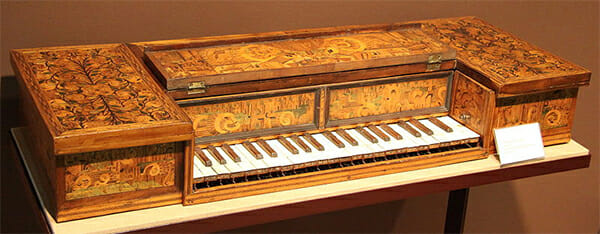
To avoid confusion, it is usually called ‘virginals‘.
This is a keyboard-like instrument which was critically acclaimed by musicians of the late Renaissance period. It was used both in concerts and households. This little harpsichord-like instrument has only one string per note. There’s no way you’re getting lost while playing it. The central portion of the instrument gives a rich tone (like a woodwind instrument) and the ends give a stringed sound.
The keyboard is fixed at the center of the instrument to make octave adjustments. Many virginals survived to this day, thanks to the rich finishing they were given.
The different types of virginals are spinet virginals, double virginals, muselars and ottavini with the main difference being the location of the keyboard and tonal ranges (low or high or medium).
At first, the virginals were made simple like the present day’s portable keyboard. Players placed this musical instrument on a table while playing. Pictures with virginals in a household usually show them on a table too. But eventually, the instrument was equipped with a stand or a case to facilitate the placement in performance venues.
Doesn’t it amaze you that way back in the 15th century, musicians could come up with musical instruments each with a specific effect?
Thankfully, Renaissance set up the stage to let them explore the art of music and to pass it to the next generations.

